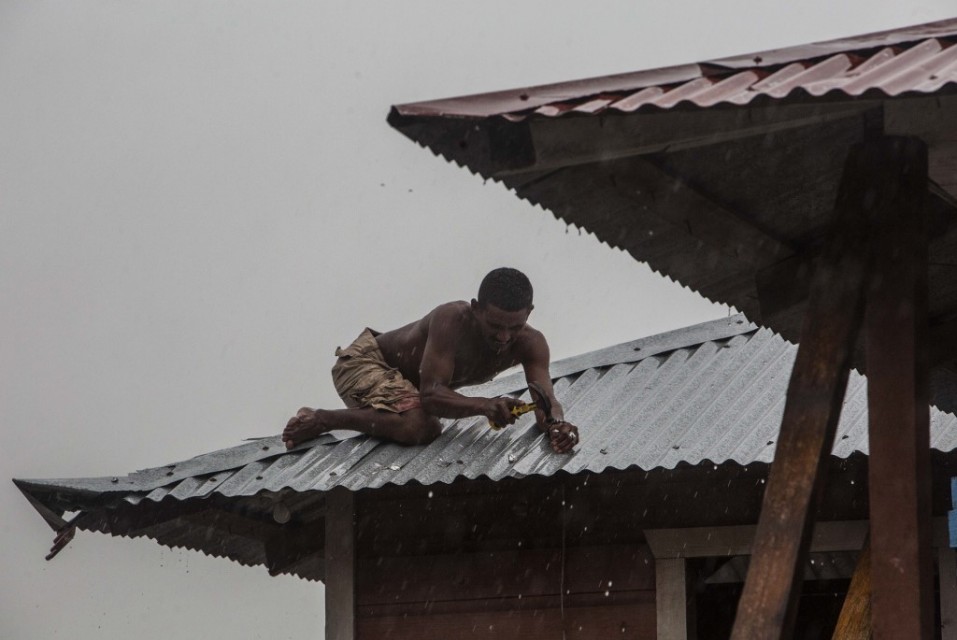
by Julia RIOS
BILWI, Nicaragua (AFP) — Iota made landfall in Nicaragua as a “catastrophic” Category 5 hurricane Monday, threatening to deliver more drenching rains and fierce winds to areas devastated by a powerful storm just two weeks ago.
Authorities had been rushing to evacuate thousands of people from coastal areas of Nicaragua and Honduras, in the immediate path of the maximum-level hurricane.
The storm had already left one person dead as it swept the Colombian Caribbean island territory of Providencia, where it caused widespread damage.
“This powerful hurricane Iota is already on the front line, it’s already on land”, said Marcio Baca, director of meteorology at the Nicaraguan Institute of Territorial Studies (INETER).
US forecasters at the National Hurricane Center (NHC) warned of “catastrophic winds, life-threatening storm surge and torrential rainfall… in Central America”.
It was packing maximum sustained winds of 160 miles (260 kilometers) per hour with higher gusts recorded.
Category 5 hurricanes destroy many homes, wreck power supplies and most of the affected area is “uninhabitable for weeks or months,” the NHC said.
Colonel John Fredy Sepulveda, the police chief on Providencia, said the local hospital had lost part of its roof and the territory of around 6,000 people was without power.
Hundreds of residents of indigenous communities on Nicaragua’s northeastern coast near the city of Bilwi were still waiting to be evacuated earlier Monday.
“With Hurricane Eta we didn’t get out, but this one is more dangerous,” said Marisol Ingram, whose wooden home was badly damaged by Eta and is at risk of being swept away by Iota.
Eta made landfall in the same area as a Category 4 hurricane in early November before easing to a tropical storm causing widespread flooding and landslides that left 200 people dead.
The 2020 Atlantic hurricane season has seen the most named storms on record, with 30 named storms and 13 hurricanes.
So many, that by October, with the arrival of tropical storm Wilfred in the eastern Atlantic, meteorologists had already used every name on the season’s list, causing them to move to the Greek alphabet for names, which had not been necessary since 2005.
Iota is the ninth letter of the Greek alphabet.
Warmer seas caused by climate change are making hurricanes stronger for longer after landfall, scientists say.
Evacuations underway
Shelters in Nicaragua, already stretched by those made homeless by Eta, were being overwhelmed by new arrivals, Eufemia Hernandez, coordinator of a center at Uraccan University, told AFP.
In Bilwi, residents spent the day desperately trying to secure roofs of flimsy wooden homes with the same zinc sheets ripped off by Eta.
Many people were wrapping their belongings in plastic bags to protect them from the coming rains.
Prinsila Glaso, an 80-year-old Miskito woman, told AFP that in her community south of Bilwi “everything is destroyed!” in the wake of Eta, and the coming Hurricane Iota would leave little behind.
“I haven’t eaten. I don’t know where I’m going to sleep here. I’m very sad,” she said.
The government in El Salvador has declared a “red alert” in advance of the hurricane. Guatemala, with vast areas still recovering from Eta, was also on high alert.
In Honduras, Iota was already causing strong gusts and heavy rainfall on Monday in the exposed eastern departments of Gracias a Dios, Colon, northern Olancho and part of Atlantida, according to disaster agency COPECO.
Local media reported that more than 175,000 people have been evacuated since Saturday, especially in areas previously flooded by Eta, including the industrial Sula Valley, north of the capital Tegucigalpa.
The NHC warned that Iota would deposit 10 to 20 inches (250 to 500 mm) of rain on Honduras, northern Nicaragua, southeast Guatemala and southern Belize, with isolated totals of up to 30 inches.
“This rainfall would lead to significant, life-threatening flash flooding and river flooding, along with mudslides in areas of higher terrain,” it said.
© Agence France-Presse







